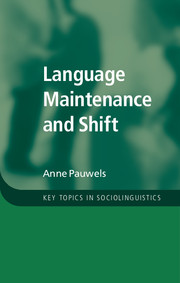Book contents
- Frontmatter
- Dedication
- Contents
- Acknowledgements
- Introduction
- PART I HISTORY, CONCEPTS, CONTEXTS AND APPROACHES
- 1 Pioneers in the study of language maintenance and language shift
- 2 Concepts, contexts and approaches to the study of language maintenance and shift
- PART II INVESTIGATING LANGUAGE MAINTENANCE AND SHIFT: COLLECTING AND ANALYSING DATA
- PART III IDENTIFYING AND UNDERSTANDING TRENDS AND PATTERNS IN THE DYNAMICS OF LANGUAGE MAINTENANCE AND SHIFT
- PART IV LANGUAGE MAINTENANCE EFFORTS AND REVERSING LANGUAGE SHIFT
- PART V FUTURE DEVELOPMENTS IN THE STUDY OF LANGUAGE MAINTENANCE AND SHIFT
- References
- Index
- References
2 - Concepts, contexts and approaches to the study of language maintenance and shift
from PART I - HISTORY, CONCEPTS, CONTEXTS AND APPROACHES
Published online by Cambridge University Press: 05 August 2016
- Frontmatter
- Dedication
- Contents
- Acknowledgements
- Introduction
- PART I HISTORY, CONCEPTS, CONTEXTS AND APPROACHES
- 1 Pioneers in the study of language maintenance and language shift
- 2 Concepts, contexts and approaches to the study of language maintenance and shift
- PART II INVESTIGATING LANGUAGE MAINTENANCE AND SHIFT: COLLECTING AND ANALYSING DATA
- PART III IDENTIFYING AND UNDERSTANDING TRENDS AND PATTERNS IN THE DYNAMICS OF LANGUAGE MAINTENANCE AND SHIFT
- PART IV LANGUAGE MAINTENANCE EFFORTS AND REVERSING LANGUAGE SHIFT
- PART V FUTURE DEVELOPMENTS IN THE STUDY OF LANGUAGE MAINTENANCE AND SHIFT
- References
- Index
- References
Summary
THE STUDY OF LM AND LS AS A SUBFIELD OF LANGUAGE CONTACT STUDIES
In the introduction of this book we already hinted that the study of LM and LS is heavily intertwined with that of related phenomena such as multilingualism, language loss, language death, language endangerment and language revival and revitalisation. All these phenomena are, in one way or another, the outcome or the consequence of a plethora of language contact situations. Contact between languages and language varieties is not only omnipresent but also the norm rather than the exception in linguistic constellations around the globe.
Mobility of people – of individuals, families, groups and entire communities – is at the source of most language contact. Reasons for mobility are multiple, ranging from individual adventurous exploring and a desire or need for trade, education or employment beyond one's own territory to the results of expulsion or invasion. All these forms of mobility, voluntary or forced, short or long term, are most likely to involve contact between speakers of different languages or language varieties. Short-term language contact between individuals or groups is not likely to induce (major) changes in linguistic constellations or the language practices of the speakers. For example, many people now holiday in places where other languages are spoken. While some holidaymakers may be motivated to learn the local language, this is not likely to reshape or affect their linguistic practices drastically, once they return from their holiday. Conversely, long-term contact between people is much more likely to have a linguistic effect. Migration – voluntary as well as forced – colonisation and invasion are the types of mobility that have had the most impact on changes in linguistic constellations and language practices. In most cases, speakers of one language move (long term or permanently) into the territory of another speech community. Where colonisation or other types of ‘invasion’ are the trigger for the contact, the language or languages of the ‘intruders’ often not only upset the existing linguistic hierarchies and dynamics but may also lead to the extinction of some of the indigenous languages.
Changes in nation-states are also possible triggers for language contact. Some of these are in fact outcomes of invasions, so they are ultimately linked to mobility.
- Type
- Chapter
- Information
- Language Maintenance and Shift , pp. 17 - 32Publisher: Cambridge University PressPrint publication year: 2016

